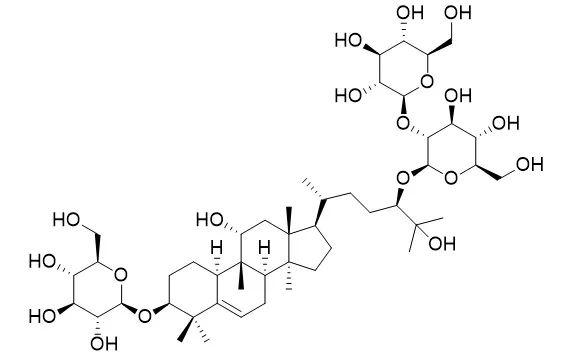| In vivo: |
| J Pharmacol Exp Ther. 2017 May;361(2):268-279. | | Mogroside IIIE, a Novel Anti-Fibrotic Compound, Reduces Pulmonary Fibrosis through Toll-Like Receptor 4 Pathways.[Pubmed: 28280123 ] | Idiopathic pulmonary fibrosis is a progressive fibrotic lung disease, and eventually most patients develop respiratory failure with a median survival rate of 2 to 3 years after diagnosis due to the lack of clinically effective therapies.
Mogroside IIIe (MGIIIE), a cucurbitane-type compound, was isolated from Siraitia grosvenorii MGIIIE has shown the strongest inhibition of nitric oxide release, a crucial inflammatory factor, from lipopolysaccharide (LPS)-treated RAW264.7 cells compared with other mogrosides.
METHODS AND RESULTS:
In the pulmonary fibrosis mouse model induced by bleomycin,
MGIIIE treatment attenuated pulmonary fibrosis, indicated as a reduction in myeloperoxidase activity, collagen deposition, and pathologic score. MGIIIE also significantly suppressed expression of several important fibrotic markers, e.g., α-smooth muscle actin, collagen I, transforming growth factor-β (TGF-β) signal, and metalloproteinases-9/tissue inhibitor of metalloproteinase-1. Furthermore, MGIIIE blocked tansdifferentiation of lung resident fibroblasts into myofibroblast-like cells induced by TGF-β or LPS and subsequently inhibited collagen production in lung fibroblasts. These data indicate that MGIIIE is a potent inhibitor for pulmonary fibrosis. In vitro and in vivo mechanistic studies have shown that MGIIIE significantly decreased expression of toll-like receptor 4 (TLR4) and its downstream signals of myeloid differentiation factor 88 (MyD88)/mitogen-activated protein kinase (MAPK), an inflammatory signal essential for extracellular matrix (ECM) deposition in pulmonary fibroblasts.
CONCLUSIONS:
Taken together, these results demonstrate that MGIIIE significantly prevents pulmonary fibrosis by inhibiting pulmonary inflammation and ECM deposition through regulating TLR4/MyD88-MAPK signaling. Our study suggests that MGIIIE may have therapeutic potential for treating pulmonary fibrosis in clinical settings. |
|






 Cell. 2018 Jan 11;172(1-2):249-261.e12. doi: 10.1016/j.cell.2017.12.019.IF=36.216(2019)
Cell. 2018 Jan 11;172(1-2):249-261.e12. doi: 10.1016/j.cell.2017.12.019.IF=36.216(2019) Cell Metab. 2020 Mar 3;31(3):534-548.e5. doi: 10.1016/j.cmet.2020.01.002.IF=22.415(2019)
Cell Metab. 2020 Mar 3;31(3):534-548.e5. doi: 10.1016/j.cmet.2020.01.002.IF=22.415(2019) Mol Cell. 2017 Nov 16;68(4):673-685.e6. doi: 10.1016/j.molcel.2017.10.022.IF=14.548(2019)
Mol Cell. 2017 Nov 16;68(4):673-685.e6. doi: 10.1016/j.molcel.2017.10.022.IF=14.548(2019)